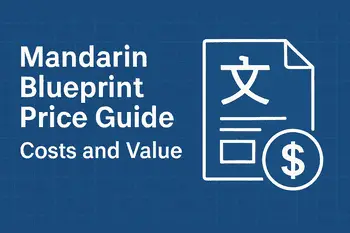
This guide explains Mandarin Blueprint pricing tiers, payment options, what you get for the money, how to evaluate value against alternatives, budgeting tips, and real-user perspectives so you can decide whether the course fits your goals and wallet.
What is Mandarin Blueprint and how it positions itself
Mandarin Blueprint is an immersive Mandarin course and coaching system that emphasizes fast progress through a structured method combining character-focused learning, memory techniques, and a progressive curriculum built to take learners from beginner toward advanced levels.
Official pricing cues and how they’re typically presented
Mandarin Blueprint promotes a tiered offering with free entry points (trial or challenge) and paid options that are commonly presented as a one-time premium purchase or subscription-like payment plans.
The vendor marketing frequently features promotional discounts tied to webinars or challenges, and occasional limited-time price reductions to incentivize sign-ups.
Typical advertised price ranges reported by reviewers and users
Independent reviews and user discussions indicate the full program often sits near a four-figure one-time price or comparable multi-month payment plans, with promotional discounts sometimes bringing that price down by a few hundred dollars.
Pricing breakdown (summary and what to expect)
- Free entry options: trial lessons, short challenges, or webinars used to introduce the method.
- Core program: typically advertised as a premium single-purchase package (advertised full price often near $997 in third-party review reporting).
- Payment-plan option: monthly installment alternatives (example: 12 months at a smaller monthly fee) reported by reviewers.
- Discounted offers: webinar or challenge completion often results in time-limited discounts (user reports indicate discounts around $200 off in some campaigns).
What you actually get for the price
Mandarin Blueprint’s core offers are structured learning modules with built-in memory and character learning systems, guided progressions through levels of spoken and written Chinese, and supplemental coaching or structured community elements depending on the package.
The course emphasizes a complete system intended to lead learners to high proficiency with a long-term study path built into the curriculum.
Is the cost justified? How to evaluate value
To decide if the price is justified, weigh the following factors:
- Learning goals: Are you aiming for conversational fluency, professional competency, or academic certification? The broader and higher your goals, the more likely a comprehensive paid program is appropriate.
- Time availability and discipline: High-quality self-study systems produce results only if you can commit the hours required; consider your schedule and the course’s time estimates.
- Comparative cost per hour: Calculate cost divided by realistic study hours to see cost-per-effective-hour vs. alternatives like tutoring, community college classes, or other apps.
- Support and structure: Premium courses justify price when they provide structured curricula, responsive coaching, and long-term learning pathways that keep you progressing.
- Retention and methodology: If the course’s mnemonic and character-first methods fit your learning style, you may achieve faster gains that offset higher upfront cost.
Price comparison table
| Option | Typical Price | Payment Type | What’s included (one-line) |
|---|---|---|---|
| Free trial / challenge | Free | Trial | Intro lessons and short challenge; discount eligibility |
| Core one-time package | ~$997 reported | One-time | Full curriculum and learning system; possible bonuses |
| Installment plan | ~$97/mo reported | Monthly for 12 months | Same as core, paid over time |
Sources: Mandarin Blueprint FluentU Reddit
How users perceive price vs value
User forums and reviews reflect a split: some learners praise the method and say it accelerates progress enough to justify the cost, while others find the price a barrier despite positive learning outcomes.
Promotional discounts and trial experiences heavily influence perceived affordability and conversion decisions.
Practical payment and budgeting advice
- Use the free challenge or webinar to test both the pedagogy and any discount eligibility before committing.
- Compare cost-per-hour: estimate realistic weekly hours and multiply across months to produce an adjusted hourly rate; compare that to tutor rates or classroom alternatives.
- If a one-time price is steep, evaluate installment plans that spread cost into manageable monthly payments.
- Factor in additional expenses like graded assessments, textbooks, or extra tutoring you might add later.
- Look for scholarship, student, or seasonal discount opportunities if available.
Alternatives to consider (value-oriented comparison)
- Private tutors: Flexible, targeted, often cheaper per-hour depending on tutor quality.
- University or community college programs: Structured classes with accreditation; may be slower but often less expensive in total.
- Self-study apps and subscription platforms: Lower monthly cost but less structured progression and fewer guarantees of long-term retention.
- Hybrid approaches: Combine a lower-cost app for daily practice with intermittent tutor sessions to tighten speaking and feedback.
How to test whether you’ll benefit from Mandarin Blueprint
- Complete any offered free challenge or trial modules to see if the method aligns with your learning style.
- Track short-term gains over 2–4 weeks: retention of vocabulary, reading ability, and speaking confidence.
- Compare those gains against the time invested and the discount offered for enrolling immediately after the trial.
- If progress is clear and the discount makes the financials acceptable, the program may be a sound investment.
Timeline expectations and real outcomes
Mandarin Blueprint claims a systematic route to advanced competency through progressive levels
Independent reviewers note the program aims to take learners from zero to very advanced over a multi-hundred to thousand-hour commitment, depending on pace and goals.
Realistic study pacing examples
- Intensive option: 10–20 hours/week — faster gains but higher time cost.
- Moderate option: 5–8 hours/week — steady progress within months.
- Casual option: 2–4 hours/week — slower gains and longer to reach advanced levels.
Pros and cons of investing in Mandarin Blueprint
Pros:
- Structured, character-focused curriculum designed for long-term retention.
- Memory and mnemonic techniques that many learners find effective.
- Clear progression toward high-level proficiency.
Cons:
- High upfront cost compared with many alternatives; price may be prohibitive for some learners.
- Success depends on sustained time commitment and consistent practice.
- Promotional pricing and discounts can make exact cost unpredictable.
How to maximize return on investment if you enroll
- Follow the program’s study schedule consistently to minimize wasted cost per hour.
- Combine course materials with active speaking practice via language partners or tutors.
- Use spaced repetition and active recall methods emphasized by the course to boost retention.
- Track milestones: HSK mock tests, speaking benchmarks, reading speed goals.
Common questions answered
Q: Does Mandarin Blueprint offer refunds or guarantees?
A: Check the vendor terms during purchase; refund policies and trial guarantees vary and are subject to the provider’s current terms Mandarin Blueprint.
Q: Can you finish the course faster by studying more hours?
Yes, but diminishing returns apply; consistent, targeted study usually beats random high-hour spikes.
Q: Is the course suitable for heritage learners?
A: The character-focused methods can help heritage learners shore up literacy and formal grammar gaps, though individualized needs may vary.
Real user voices and independent reviews
Independent reviewers who tested the platform praised the depth and efficacy of the method but called out the price as a major consideration for many learners.
Community discussions show learners who achieved significant progress and learners who paused because of cost concerns; promotions and discounts often shift the balance toward enrollment for fence-sitters.
Final recommendation framework (how you should decide)
- Try the free entry point to evaluate fit Mandarin Blueprint.
- Measure progress over the trial period against your targeted timeline and goals.
- Calculate cost-per-effective-hour and compare to tutors or other formal programs.
- If progress is clear and the discounted price (if available) fits your budget, enroll; otherwise, consider mixing lower-cost resources with targeted tutoring.
Next steps and links
- Mandarin Blueprint official site: https://www.mandarinblueprint.com/.
- Independent review with reported price examples and reviewer experience: https://www.fluentu.com/blog/reviews/mandarin-blueprint/.
- Community discussion on pricing and perceived value: https://www.reddit.com/r/ChineseLanguage/comments/17x4w7y/mandarin_blueprint_users_what_do_you_think_the/.
Closing thought
A high-quality, structured course can be a strong accelerator if you commit the time; cost matters, but the most important factor is consistent practice and alignment between method and your learning preferences.


